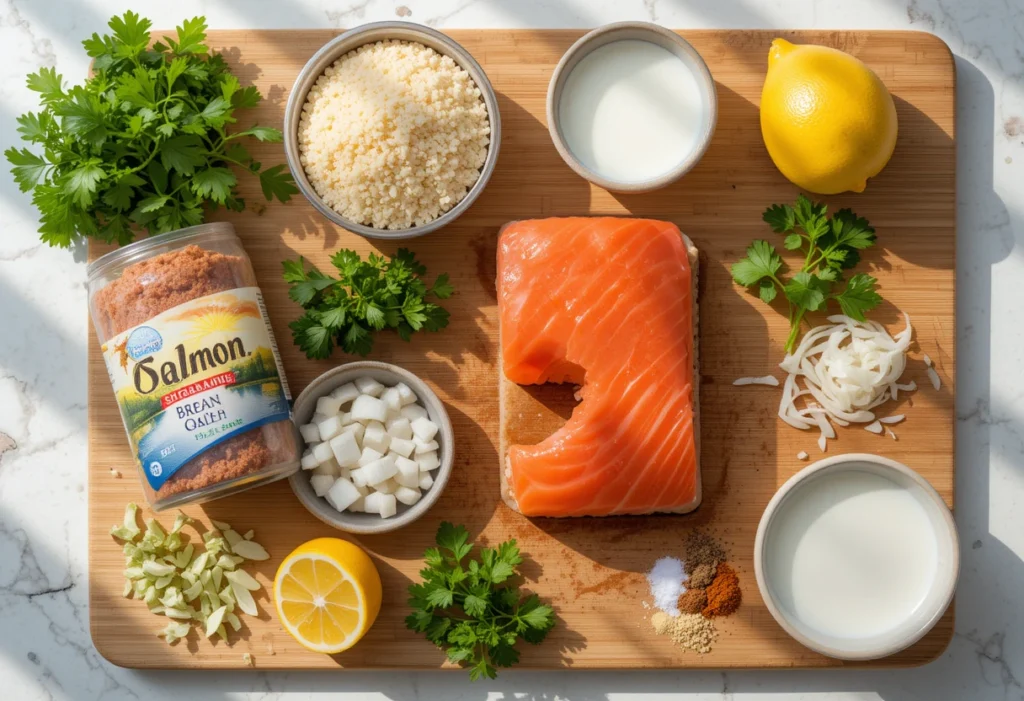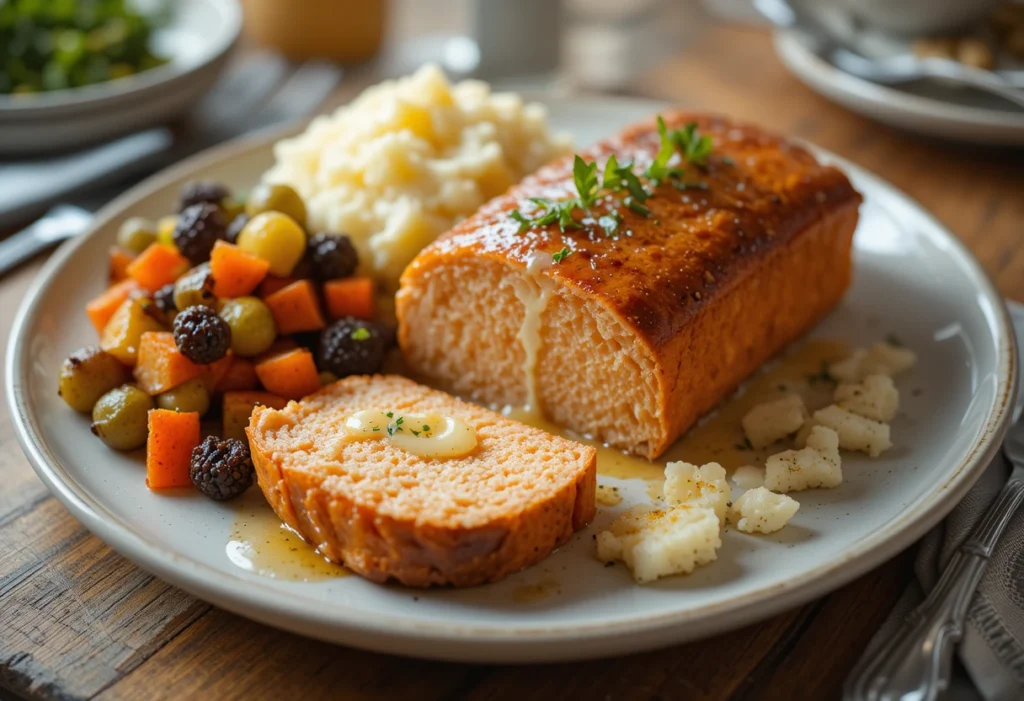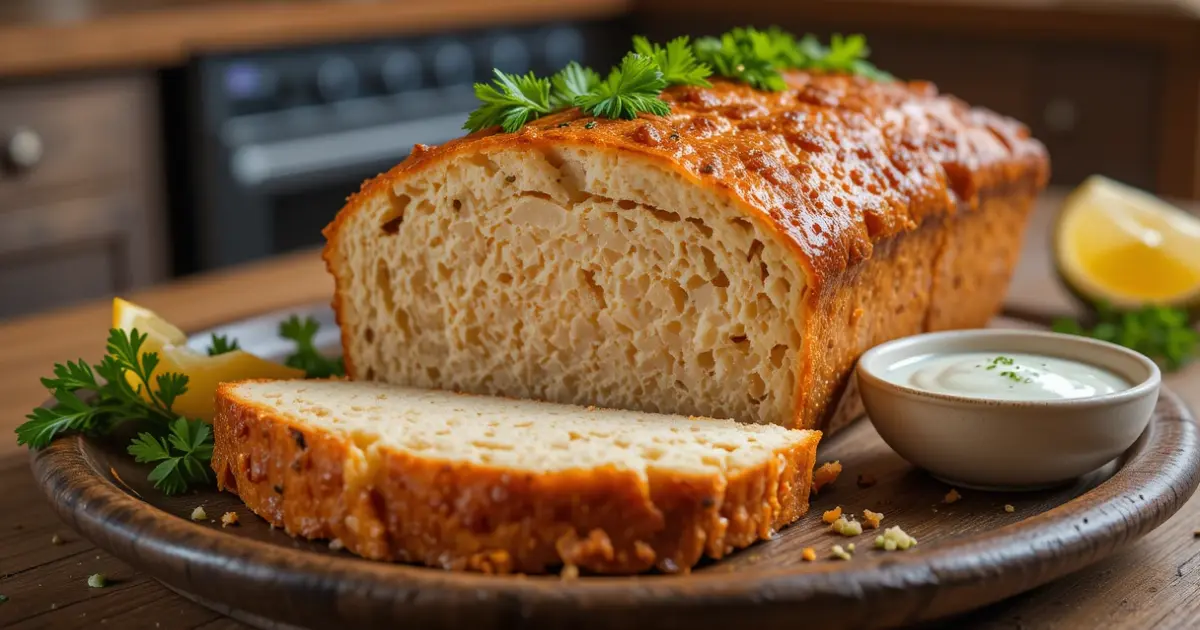Picture yourself pulling a perfectly golden-brown salmon loaf from the oven, its aroma wafting through your kitchen, carrying promises of a meal that’s both nutritious and deeply satisfying. Remember those cherished moments when your grandmother would present her signature dishes at family gatherings? That’s exactly the kind of warmth and comfort you’ll create with this exceptional baked salmon loaf recipe.
Through years of culinary exploration and countless hours spent perfecting this classic dish, I’ve discovered that creating the ideal baked salmon loaf is a beautiful balance of technique and intuition. Today, you’ll learn every secret, every nuance, and every tip needed to craft a salmon loaf that will become your own family tradition.
Table of Contents
Why Choose Baked Salmon Loaf?
There are plenty of reasons to add this dish to your cooking routine:
- Nutritious and Heart-Healthy: Salmon is rich in omega-3 fatty acids, which support brain function and heart health.
- Easy to Prepare: With minimal prep and simple ingredients, it’s perfect for busy schedules.
- Great for Meal Prep: It stores well, making it an excellent option for leftovers.
- Affordable: Canned salmon is a cost-effective way to enjoy seafood.
- Versatile: You can tweak the flavors to suit your taste, from classic to spicy variations.
Essential Ingredients for Your Salmon Loaf
Before diving into the preparation, let’s gather everything you’ll need. Quality ingredients make the difference between a good salmon loaf and an extraordinary one. Here’s your comprehensive shopping list:
| Ingredient | Amount | Notes |
|---|---|---|
| Fresh salmon | 2 pounds | Skinless, deboned |
| Breadcrumbs | 1 cup | Plain or seasoned |
| Eggs | 2 large | Room temperature |
| Onion | 1 medium | Finely diced |
| Celery | 2 stalks | Finely chopped |
| Milk | 1/2 cup | Whole milk preferred |
| Lemon juice | 2 tablespoons | Freshly squeezed |
| Fresh dill | 2 tablespoons | Chopped |
| Salt | 1 teaspoon | To taste |
| Black pepper | 1/2 teaspoon | Freshly ground |

Kitchen Tools You’ll Need
Your culinary journey will be smoother with the right equipment at hand. Make sure you have:
- A sturdy 9×5 inch loaf pan
- Several mixing bowls of varying sizes
- A reliable food processor
- Accurate measuring cups and spoons
- A kitchen thermometer
- Sharp knives for preparation
- Parchment paper
- Clean kitchen towels
The Art of Preparation
1. Preparing the Salmon
The foundation of your baked salmon loaf begins with properly prepared fish. Here’s how to ensure you’re starting on the right foot:
Begin by carefully examining your salmon fillet. Run your fingers gently over the flesh to detect any remaining pin bones. Use tweezers to remove them if necessary. The skin should be completely removed, as it can affect the texture of your final dish.
Next, cut the salmon into manageable pieces, roughly 2-inch cubes. This step facilitates even processing later. Pat each piece thoroughly dry with paper towels – this is crucial for achieving the right texture in your finished loaf.
2. Creating the Perfect Mixture
This stage is where science meets artistry. Your goal is to achieve a mixture that’s cohesive but not overworked. Here’s your step-by-step guide:
- Place the cubed salmon in your food processor. Pulse in short bursts until the fish is finely chopped but not reduced to paste. You’re looking for a texture similar to rough breadcrumbs.
- In a large mixing bowl, combine your processed salmon with:
- The finely diced onion and celery
- Fresh chopped dill
- Breadcrumbs
- Beaten eggs
- Milk
- Lemon juice
- Salt and pepper
- Using clean hands or a wooden spoon, gently fold the ingredients together until just combined. The key word here is ‘gentle’ – overworking the mixture will result in a dense, heavy loaf.
3. Mastering the Baking Process
This is where your attention to detail truly pays off. Follow these precise steps:
- Preheat your oven to 350°F (175°C). Position a rack in the center of the oven for even heat distribution.
- Prepare your loaf pan by lining it with parchment paper, leaving some overhang on the long sides. This makes removal effortless later.
- Transfer your salmon mixture to the prepared pan, pressing it down gently to eliminate air pockets. Smooth the top with a spatula.
- Bake for 45-50 minutes, or until the internal temperature reaches 145°F (63°C).
Expert Tips for Success
Your journey to creating the perfect baked salmon loaf doesn’t end with the basic recipe. Here are professional insights that will elevate your dish from good to extraordinary:
Quality Ingredients Matter
When selecting your salmon, opt for wild-caught varieties when possible. They typically offer superior flavor and texture. If fresh isn’t available, flash-frozen salmon can be an excellent alternative – just ensure it’s completely thawed and properly drained before use.
The breadcrumbs you choose significantly impact your loaf’s texture. While store-bought varieties work well, consider making your own by pulsing day-old sourdough bread in a food processor. This small effort adds a distinctive homemade touch that your guests will notice.
Temperature Control
Pay attention to these crucial temperature considerations:
- Allow your eggs and milk to reach room temperature before mixing
- Don’t rush the preheating process – give your oven ample time
- Use a reliable meat thermometer to check doneness
- Let the loaf rest for 10-15 minutes after baking
Serving Suggestions That Impress

Complementary Sauces
A great sauce can transform your baked salmon loaf from delightful to unforgettable. Here are three outstanding options:
Classic Dill Sauce
- 1 cup sour cream
- 3 tablespoons fresh dill, finely chopped
- 1 tablespoon lemon juice
- 1 teaspoon Dijon mustard
- Salt and white pepper to taste
Lemon-Butter Sauce
Combine melted butter, fresh lemon juice, minced garlic, and chopped parsley for a bright, rich accompaniment that enhances without overwhelming.
Creamy Mustard Sauce
Whisk together mayonnaise, whole grain mustard, honey, and a splash of white wine vinegar for a sophisticated twist.
Perfect Side Dishes
Your baked salmon loaf deserves thoughtfully chosen accompaniments. Consider these pairings:
- Roasted Asparagus with Garlic
- Toss fresh asparagus with olive oil, sea salt, and sliced garlic
- Roast at 400°F until tender-crisp
- Finish with a squeeze of lemon
- Garlic Mashed Potatoes
- Use Yukon Gold potatoes for creamy texture
- Add roasted garlic for depth
- Incorporate warm milk and butter gradually
- Fresh Green Salad
- Mix crisp lettuce varieties
- Add cucumber, cherry tomatoes, and red onion
- Dress with a light vinaigrette
Storage and Reheating Guidelines
Proper Storage
To maintain the quality of your baked salmon loaf:
- Refrigeration:
- Cool completely before storing
- Wrap tightly in aluminum foil or plastic wrap
- Store in an airtight container
- Consume within 3 days
- Freezing:
- Wrap individual portions in plastic wrap
- Place in freezer bags, removing air
- Label with date and contents
- Freeze for up to 2 months
Reheating Instructions
To preserve moisture and flavor when reheating:
- From refrigerated:
- Let stand at room temperature for 15 minutes
- Preheat oven to 325°F
- Heat covered for 15-20 minutes
- From frozen:
- Thaw overnight in refrigerator
- Follow refrigerated reheating instructions
- Add 5-10 minutes to heating time
Troubleshooting Common Issues
Even experienced cooks encounter challenges. Here’s how to address common problems:
Too Dry?
- Add an extra egg to your next batch
- Increase milk by 2 tablespoons
- Reduce baking time by 5 minutes
- Check oven temperature accuracy
Too Wet?
- Add more breadcrumbs gradually
- Let mixture rest for 10 minutes before baking
- Ensure salmon is well-drained
- Consider using less milk next time
Falling Apart?
- Add an extra egg binder
- Press mixture more firmly into pan
- Allow proper cooling time
- Check breadcrumb proportion
Frequently Asked Questions
Q: Can I use canned salmon for this baked salmon loaf?
A: Yes, while fresh salmon creates the optimal texture, canned salmon works in a pinch. Choose high-quality, skinless and boneless varieties, and drain thoroughly. You might need to adjust the moisture content slightly.
Q: How do I prevent my baked salmon loaf from being too dry?
A: Success lies in proper proportions and timing. Monitor internal temperature closely, avoid overbaking, and ensure your mixture includes adequate moisture-rich ingredients like eggs and milk.
Q: Can I make baked salmon loaf ahead of time?
A: Absolutely! Prepare the mixture up to 24 hours ahead and refrigerate. Allow it to come to room temperature for 30 minutes before baking. Alternatively, bake completely and reheat following our guidelines.
Q: What’s the best internal temperature for a baked salmon loaf?
A: Aim for 145°F (63°C) at the center. This ensures food safety while maintaining moisture and texture.
Conclusion
Creating the perfect baked salmon loaf is a journey worth taking. With these comprehensive guidelines, you’re now equipped to craft a dish that’s both nostalgic and sophisticated. Remember that each time you prepare this recipe, you’re not just making dinner – you’re creating memories and perhaps starting a new family tradition.
Your baked salmon loaf journey doesn’t end here. Experiment with herbs, try different sauce combinations, and make this recipe truly your own. The best dishes evolve through personal touches and adaptations.
Share your creations with loved ones, gather feedback, and most importantly, enjoy the process of mastering this classic comfort dish. Now, it’s time to head to your kitchen and start creating your own perfect baked salmon loaf.
Remember, the key to success lies not just in following instructions, but in bringing your own passion and creativity to the process. Happy cooking!
So, what are you waiting for? Grab your ingredients and get cooking! And if you love this recipe, don’t forget to share your experience in the comments.
